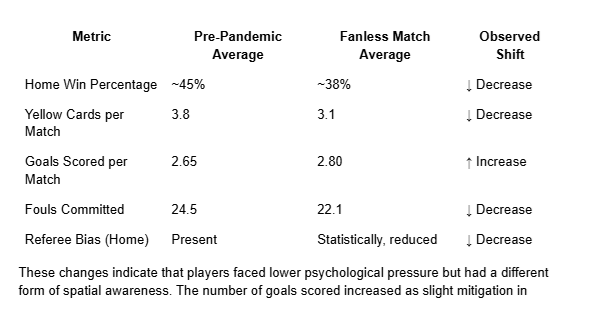Football without fans: what the pandemic showed
The Covid-19 pandemic made the world football experience before before. The closed door matches eliminated the public live, and with them the feeling, rhythm and sports economy. The teams from Europe to South America had to adapt to this new standard, but the silence they faced was deafening.
Without songs, crowd reactions or any pressure quaudence, the parties lost their intensity and became more surprising more clinical; The advantage of the house disappeared. Unlike pre -pandemic time, the emitters had to implement sounds of artificial crowds to create their own version of a family environment. Football, as we know it, was now suddenly devoid of its distinctive energy factor that fans brought.
Performance, pressure and empty stadium factor
Perhaps the most analyzed effect of empty stages is the remarkable fall in the advantage of the field of origin. Throughout the main European leagues, local teams won considerably less teams won significantly more compared to the previous seasons. The psychological “neutrality” of the fans devoid of fans, who changed the flow of the game and the attitude of the referee, even altered the perceptions in almost almost Soccer Betting Site As the probabilities adjusted due to the home lining bias framework. The players seemed to work under less pressure, but so much relaxation, without urgency, and many less known franchises surpassed in this environment.
Without spectators, it was observed that the communication in the tone was clearer, but the intensity decreased. Due to the absence of fans motivating comments, players had to trust their own motivation to remain in the game. This inspiration encouraged quiet decision making for some players, but for many others, its completely competitive spirit decreased. While it was observed that tactical discipline improved in certain leagues, creativity and cunning were incredibly difficult to promote.
Statistical trends: what changed during football without a fan
To understand the complete scope of the change, it is useful to observe the key performance indicators that changed during the non -spectator phase of the pandemic. Several metrics demonstrated measurable deviations:

These changes indicate that the players faced a lower psychological pressure but had a different form of spatial consciousness. The number of goals marked increased as a slight mitigation occurred in defensive compact. The general tone of the party was more moderate, highlighted by less aggressive letters and offenses, probably due to less provocations.
Absence of fans and transmission innovation
The absence of fans in the stadiums raised a challenge for clubs and broadcasters, which forced them to rethink how matches at home were experienced. Some leagues incorporated noise of artificial crowds in live broadcasts, while others tried to use wall fans, cut fans, augmented reality audience simulations or even digital replicas for greater realism. These temporary solutions tried to maintain some atmosphere, but greatly transformed the way football occurred as an entertainment piece.
There was an explosion in the use of transmission platforms and second screen experiences, especially through mobile applications, such as the Melbet application that presented live party trackers and real -time probabilities that were extended along with the transmission. Betting to the public were quickly adapted by being more interested in game statistics and visualization tools instead of impulse signals driven by the crowd.
This evolution pushed clubs to update digital infrastructure, improve mobile interactivity and explore monetization beyond the door receipts, an axis that has since influenced long -term media strategies, even when fans have returned.
African football: a different type of absence
Losing fans in the context of African football meant more than the game. Many lower level leagues operate in the income and culture of fans as a form of tickets for tickets. Supporters in countries like Nigeria, Ghana and Kenia are part of the club emotionally. That link was lost during the pandemic.
Some stadiums became public health facilities or simply remained inactive for months. Local Derby matches such as Gor Mahia vs. AFC Leopards or Enyimba vs Kano Pillars lost their joy and emotion. Add to that the already scarce television coverage obtained by these leagues. Without fans in the stadium, the games are invisible. Transmission companies emerged, but low infrastructure and data limits consistently delayed adoption.
African clubs suffered deeply during pandemia. Although European clubs had commercial agreements and global transmission rights as an alternative, many African clubs lacked financial and emotional support. The need to develop digital solutions focused on Africa became more evident during pandemic. There was a growing interest in mobile solutions such as Télécharger Melbet Ack, which can fill the gaps where formal coverage fails.
Tactical and coaching adjustments
Without the influence of the crowd, tactical flexibility increased. Coaches could communicate more clearly, broadcast live corrections and implement subtle settings in the middle of the game. In quieter stadiums, the positioning of the players was more precise, and the defensive units operated with greater cohesion. However, some attacking players fought without impulse driven by the crowd or psychological pressure applied to defenders.
The managers also experienced more with formations and rotations of players, knowing that the intense scrutiny of the media and the reaction of the fans were momentarily reduced. This created a temporary laboratory for strategic innovation, a period in which the risk taking was more tolerated.
Many tactical patterns of the pandemic era, such as inverted backs, overloads of the center of the countryside and the ultra -tapestry, have persisted beyond the return of fans, demonstrating that the silent period encouraged long -term strategic change.

Long -term impact on player development and mental preparation
One of the most reported impacts of the era without a fan is its effect on player’s psychology, particularly the impact on younger players. The absence of tens of thousands of spectators meant that the debutants entered professional games under relatively moderate stress levels. This relaxation in the pressure roofs allowed a faster integration of the youth perspectives, due to the clubs that faced financial barriers and could not pay new signings.
At the same time, more experienced players informed having lost their focus on the game and became prone to “zone.” Sports psychologists pointed out that external factors such as support screams, hecks or applause have an unrecognized purpose of attracting attention in the game. The absence of this layer required that athletes build richer internal motivational frames and structures prior to game.
Particularly for goalkeepers and defenders, noise reduction facilitated a better organization, but also eliminated the improvised tempo that characterizes high -risk games. The energy loop between fans and players broke, and that revealed how fundamental are the live spectators for the psychological architecture of football.
 JamzNG Latest News, Gist, Entertainment in Nigeria
JamzNG Latest News, Gist, Entertainment in Nigeria









